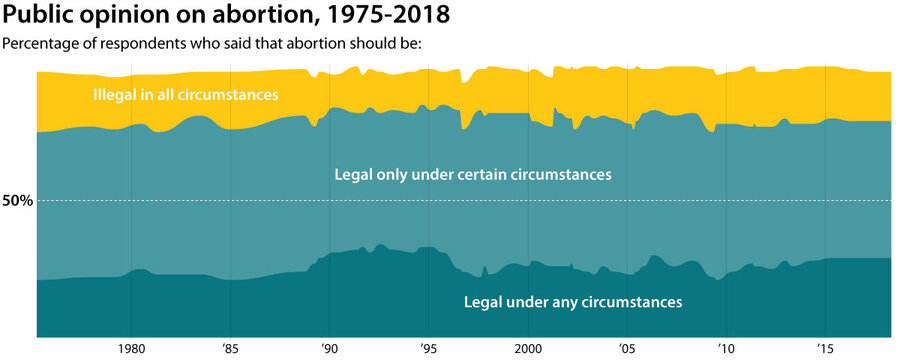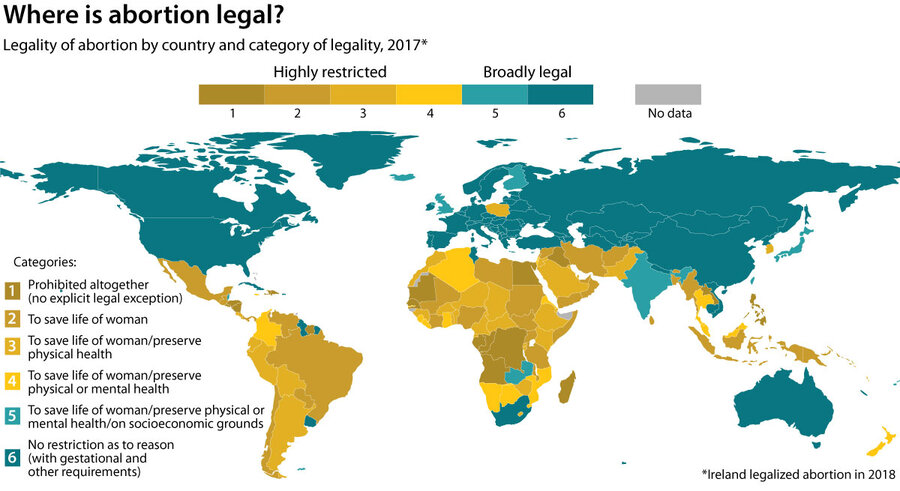As abortion battles intensify in states, misperceptions abound
Loading...
Take this question: Do you think decisions about pregnancy should be between a woman and her doctor?
Now take this question: Do you think a woman should be able to walk into an abortion clinic and have an abortion in the first trimester for any reason?
Why We Wrote This
Extreme rhetoric by activists on both sides often shapes the abortion debate and can influence public attitudes. Here are some basic facts about abortion access and public opinion about abortion in the U.S. today. This is Part Two of our series, "Looking past Roe."
If your answer changed based on the way the question was framed, you’re not alone. In talking about abortion, terminology and selective bits of context can easily push people from one position to another. “The majority of Americans, they’re highly susceptible to being influenced by the wording of the question,” says Daniel Williams, a professor at the University of West Georgia.
In reporting our series on abortion, we encountered many misperceptions and changes in attitude based on the language used. Overheated political rhetoric isn’t helping, with many states currently moving either to sharply restrict or to secure abortion access in the event that Roe v. Wade is overturned by the Supreme Court. This article attempts to establish some basic facts about abortion in the U.S. and the public perceptions surrounding it.
Take this question: Do you think decisions about pregnancy should be between a woman and her doctor?
Now take this question: Do you think a woman should be able to walk into an abortion clinic and have an abortion in the first trimester for any reason?
If your answer changed based on the way the question was framed, you’re not alone. This highlights one challenge in talking about abortion in the United States. Terminology and selective bits of context can easily push people from one position to another.
Why We Wrote This
Extreme rhetoric by activists on both sides often shapes the abortion debate and can influence public attitudes. Here are some basic facts about abortion access and public opinion about abortion in the U.S. today. This is Part Two of our series, "Looking past Roe."
“A minority of Americans on either side [of the abortion issue] are strongly energized, while a large number are uncomfortable but flexible, depending on how the question is phrased,” says Daniel Williams, a professor at the University of West Georgia. “The majority of Americans, they’re highly susceptible to being influenced by the wording of the question.”
In reporting our series, we encountered many misperceptions and changes in attitudes based on the language used. For example, people had different reactions to a procedure described as “early termination, as recommended by a doctor” than they did to “an abortion due to fetal abnormalities.” But these statements could describe the exact same situation.
Political rhetoric isn’t helping. Last month, at a rally in Green Bay, Wisconsin, President Donald Trump claimed that Democrats are “aggressively pushing extreme late-term abortion, allowing children to be ripped from their mother’s womb right up until the moment of birth.” He stated that there are situations in which after the baby is born, “they wrap the baby beautifully, and then the doctor and mother determine whether or not they will execute the baby.”
PolitiFact rated this claim as false. Though there isn’t hard data on the reasons for late-term abortions, we know they are rare. Some are performed due to an immediate threat to the life of the mother, or because the infant has severe abnormalities that make survival outside the womb unlikely. In these cases, the parents and doctors must discuss whether or not to resuscitate the child if it stops breathing – something many have described as a wrenching, emotional decision. But “executing” the baby? That does not happen.
“The notion that anyone supports executing infants after birth is preposterous,” Gretchen Ely, an associate professor at the University at Buffalo’s School of Social Work and a board member for Social Workers for Reproductive Justice, told PolitiFact.
At the same time, those who support abortion access often portray abortion opponents as hostile to the rights of women. Pennsylvania state Rep. Brian Sims, a Democrat, recently drew attention for videos he posted of himself confronting anti-abortion protesters outside a Planned Parenthood in Philadelphia.
“They’re racist, classist, bigots who NEED & DESERVE our righteous opposition,” Representative Sims tweeted with his video. In another tweet, he wrote, “Planned Parenthood protesters are scum! I’ve spent years as a patient escort witnessing firsthand the hate, vitriol, hostility and BLATANT RACISM they spew.”
Amid the extreme rhetoric on both sides, basic facts about abortion in the U.S. often get lost. This article attempts to cut through some common misperceptions surrounding the issue.
How does the American public feel about abortion?
In the U.S., overall attitudes surrounding abortion have remained relatively unchanged over the past 20 years. Nearly six in 10 Americans say that abortion should be legal in all or most cases. What has changed is the partisan divide: today, 76% of Democrats say abortion should be legal in most cases, with only 36% of Republicans in agreement. In 1995, 64% of Democrats favored legal abortion, with 49% of Republicans in agreement.
Several Democrat-led states have been removing certain restrictions on abortions in cases of serious health concerns. Does this mean a woman can get a voluntary abortion right up until birth in states like Massachusetts and New York? That’s not the case. Forty-three states, including those two, prohibit abortions after a certain point in the pregnancy. The only exceptions are when the health or life of the mother is at risk or because of the viability of the fetus.
At the same time, many Republican-led states are moving to further restrict abortions. At least five states – including Louisiana, Arkansas, and North Dakota – have passed “trigger” laws, which will immediately ban abortion in the state if Roe v. Wade were to be overturned. Georgia recently became the fourth state to pass a “heartbeat bill,” which would ban abortions after a fetal heartbeat is detected, typically around the sixth week of pregnancy. In Alabama, lawmakers are poised to vote this week on a near-total abortion ban. Most of these legislative efforts are expected to face court challenges.
Some state supreme courts, meanwhile, are issuing rulings based on their own constitutions that will stand even if Roe is overturned. In April, the Kansas Supreme Court ruled that the state’s constitution protects a woman’s right to terminate her pregnancy. The bipartisan ruling focused on the state’s protection of “personal autonomy” and the ability of individuals to make their own decisions when it comes to their own bodies.
Is the abortion rate going up in the United States?
The simple answer? No. It’s actually the lowest it’s been since the 1980s.
According to a report by the Centers for Disease Control and Prevention, from 2006 to 2015 the total number of reported abortions decreased by 24 percent.
So what’s driving the reduced abortion rate? Like many aspects of the conversation, it’s complicated.
One factor, depending on the state, is better access to contraceptives and health care. After the passage of the Affordable Care Act, most private health insurers were mandated to provide access to all FDA-approved contraceptives without cost-sharing since 2012. This, in addition to the expansion of Medicaid, made birth control more accessible and more affordable. According to the Guttmacher Institute, low-income women are more likely to have unintended pregnancies than more affluent women. With more women having access to and using birth control, the need to address an unplanned pregnancy decreases.
But wait, is it possible the abortion rate is decreasing because of more restrictions on abortion?
Depending on the state, yes. “A lower abortion rate may be a result of a decrease in abortion access services,” says Elizabeth Nash, a state policy analyst for the Guttmacher Institute. “It may be because of access to health care, or it may be because of state restrictions that close abortion clinics.”
Take Texas, for example. Before 2013, the state had 42 abortion clinics. After the passage of Texas House Bill 2, which required abortion providers to have admitting privileges at a hospital within 30 miles of the facility where he or she performs abortions, that number went down to 21 (as of 2019). With fewer clinics, longer wait times, and less access, there is simply less capacity to provide abortion care in the state.
Globally, however, laws restricting access to abortions have little impact on reducing abortion rates. In fact, abortion rates are slightly higher in countries with more restrictive access to abortion.
Ms. Nash points out that many countries that restrict abortion access develop underground networks for providing illegal abortion services. This has not happened in the U.S. since 1973, when Roe v. Wade upheld the legality of abortion. In 1965, illegal abortions accounted for one-sixth of all U.S. pregnancy-related deaths.
“Highly restrictive laws do not eliminate the practice of abortion, but make those that do occur more likely to be unsafe,” a 2018 report by the Guttmacher Institute states.
“It’s naive to think that abortion being banned means there would be no abortion. What that means is abortion would be available to those with money and means, and much less available to those with fewer resources,” Ms. Nash says.
Who is getting abortions? And when are they getting them?
Three in four abortion patients are low-income, and one of the most common reasons they cite for seeking an abortion is that they can’t afford a child. Most already have children, and most are in their 20s.
Nearly two-thirds of abortions occur within the first eight weeks of pregnancy, with almost all abortions (91.1%) occurring within the first trimester (before 13 weeks). Some 7.6% of abortions occur between 14 and 20 weeks’ gestation, and 1.3% occur after 21 weeks, which is about halfway through the second trimester.
What about “late-term” abortions?
Medically and legally, there is no definition for late-term abortion. However, when that term is used, it typically means after the 21st week of pregnancy, when the fetus may be viable, or capable of living independently, outside of the womb. Because there is no technical definition, there are a lot of misperceptions around what late-term abortion really means.
The statistics of late-term abortions do only so much to clarify the issue, but they do show that they are rare: 1.3%. Very little research has been done to show why these abortions take place. In some cases, they take place due to severe medical complications that mean the fetus will not be able to live outside the womb or that risk the life of the mother. There have also been cases where women sought and received abortions later in their pregnancies because they could not get access to an abortion sooner. Statistically speaking, there is little concrete data to show the main cause of late-term abortions. This leaves room for activists on both sides of the issue to create a narrative that fits their purposes.
“We don’t have any data about abortions in the third trimester – what are they for, what are the reasons for them?” Ms. Nash says. “Not having information allows people to spread misinformation, because there isn’t solid evidence to rebut it.”
Staff writer Jessica Mendoza contributed to this report.













